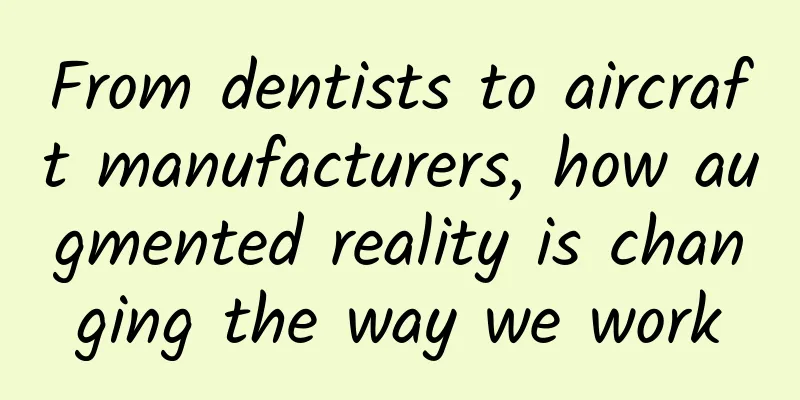From dentists to aircraft manufacturers, how augmented reality is changing the way we work

|
Like most dentists, Sven Holtorf knows his patients don't want to visit him. "Every time you go to the dentist, you're scared, you're uncomfortable, you're in pain, and it's not fun," he says. But Holtorf recently invented something he thinks will alleviate some of that discomfort. It's not a new drill or anesthetic, but a pair of glasses. Holtorf's device is an eyeCAD-connect system that includes some augmented reality software developed by his company iDENT, which runs on a pair of smart glasses developed by the technology company Epson. When Holtorf performs a dental examination, he wears the glasses but can still see the patient's mouth clearly - not only that, but also superimposed on his field of vision is a real-time display of data from the dental scanner. Once the scan is complete, Holtorf can send the data to a lab, where technicians can create a virtual model of the patient's teeth based on the data and use it to design the device the patient needs, such as dentures or braces. In the past, when dentists needed to scan a patient's teeth, they had to hold a camera and look at a monitor next to them - just like an ultrasound. But with these glasses, dentists can scan while examining the patient, and the scan will be displayed in real time on the augmented reality glasses, Holtorf said. "So it avoids us looking at the monitor while scanning, and we don't lose contact with the patient."
Augmented reality is spreading across the world, from dentists’ offices to oil pipelines to fighter jets. Used properly, it can help make jobs more efficient and safer. But manufacturers currently face many challenges in designing products that are truly useful. Gabe Batstone, CEO of augmented reality software company NGRAIN, recounted some of his favorite product application experiences. In an oil field in Canada, he installed a clamp on a pipe without any experience. In fact, he simply took out his smartphone, placed it on a metal rack, and followed the instructions on the screen. On the screen, Batstone could see the actual pipeline captured by the phone camera and the steps he should perform. "As a person who knew nothing about this clamp, I walked through the whole process. Ordinary people can complete this technology as if they can actually do this job." Lockheed Martin is also one of NGRAIN's customers. During the manufacturing process of aircraft (especially the F-35 and F-22 fighters), workers need to perform some visual inspections on the aircraft to ensure that the stealth technology of each aircraft is working properly. Similarly, Batstone said that he could complete such inspections on the factory floor by himself without any experience. "I looked at it and I thought, 'Wow, this is so easy.'"
But while such systems can help new flight engineers like Batstone perform specific tasks, it’s much harder to provide professionals with information to help them do the same job. The first thing these companies need to figure out is what augmented reality technology workers need to assist them in their work tasks. “I think a lot of people think it’s just replicating the real world on a screen, but that’s not the case; it’s about providing context and segmenting the world,” Batstone said. It takes a lot of research and thought to figure out what information a company has and what information it can show to workers to help them do their jobs better. Next, companies like NGRAIN and iDENT need to find ways to use this information to create augmented reality applications. This usually involves designing image recognition systems so that the work content can be recognized through the camera of glasses or tablets. "It's like facial recognition software, but for machines." Batstone explained, but the system they designed may be more difficult than facial recognition. "It's easy to distinguish faces, but it's much more difficult to distinguish some large pieces of gray metal." When it comes to Holtorf and his dentist glasses, there's an additional complication: lag time. For applications like inspecting oil pipelines and stealth aircraft, a half-second lag between camera and display isn't a big deal, but for work like treating teeth that requires tinkering with the human body, the real-time requirements of the dentist's scanner and glasses' display are essential. Holtorf and his colleagues solved this problem in two ways. One is to use the local network instead of relaying data over the Internet, thus avoiding the delay caused by the data being transmitted to the remote server. In addition, the local network has security advantages. Holtorf said: "This way, sensitive data will stay local, so we can ensure that all sensitive data stays in the office."
The second approach is to reduce the resolution of the image scans. "We have to reduce the resolution a little bit to avoid latency, and that's OK for now," Holtorf said, adding that they hope the next generation of devices will offer better image resolution. Technical problems are relatively easy to overcome, but the hard part is people. No matter how amazing your system is, it’s worthless if customers don’t want to use it. “People who do those jobs have been working for a long time without your technology,” Batstone said, so it’s hard to convince them to use tablets or glasses to help them do the work they’ve been doing for years. Why did some early augmented reality glasses fail to really work? It was because workers refused to wear them. And in Holtorf's field of dentists, people have readily embraced the technology. His team demonstrated the device they developed for dentists at a conference and received enthusiastic support. "Everyone who has used the scanning device says, 'Great, great, it's great,' even experienced users." Holtorf says his patients have noticed a difference, too. "Most of them say, 'Yeah, you use this on me every time instead of those machines.'"
When asked if he's considered other medical uses for the glasses, Holtorf laughed, "Of course, we have a lot of ideas." He imagines augmented reality glasses could help during delicate surgeries, for example, when doctors need to search for tissue beneath the skin. But for now, Holtorf said they'll continue to work on making the dental glasses as perfect as possible. So the next time you have a dental checkup, keep an eye out for your doctor wearing an unusual pair of glasses; your teeth might be the only thing in their field of vision. |
<<: New record! App Store sales hit $1.1 billion in two weeks during holiday season
>>: Aipoly: Building a virtual reality for nearly 300 million people in the world
Recommend
Can Mobike’s credit score really control the random parking of shared bicycles?
Some time ago, shared bicycles were regulated in ...
Those who only look at the CTR of information flow ads are all hooligans! Attached effect case
Most of the articles on the market about informat...
Annual salaries of car company executives revealed, even 30 million can’t make it into the top five, so state-owned enterprises can’t beat private enterprises?
Recently, the salary dispute among senior executi...
The ozone in the air made them fall in love with the wrong person
Produced by: Science Popularization China Author:...
Does dating make you fat? Does “love brain” make you less intelligent? Are these true?
The most vicious curse for a young person, beside...
WeChat mini program bargaining software, how to make the WeChat mini program bargaining software?
WeChat mini program bargaining software, how to m...
Growth hacking in action
The Internet is the most disruptive engine in mod...
The secret of Kuaishou Express Ads
As the saying goes, "The food and fodder mus...
With a range of over 450km, Qoros 3 EV may be launched in November
Recently, Qoros Auto's senior management anno...
The smallest quantum light detector can be integrated on a silicon chip!
The smallest quantum light detector on a silicon ...
The science behind hangovers is actually...
According to a report on the U.S. News Weekly web...
Is the smart TV market really activated? Applications need to be more powerful!
In the era of rapid development of the Internet, ...
One picture to understand | Beijing releases cancer monitoring data, who is the "number one killer"?
Editor/Ding Lin Art Editor/Lancheng New Media Edi...
Summary of 31 SEO interview questions and 4 interview skills!
If you have SEO skills, you should use them. You ...
A must-have user growth map for new product developers
User growth is an eternal topic in the Internet c...









